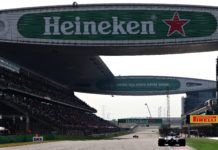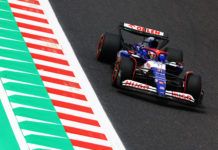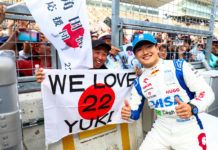Before the mid-season break, the Formula One teams visited the slowest permanent track on the calendar: the Hungaroring. Now they head to one of the quickest of all: Spa-Francorchamps, in the foothills of the Ardennes. Pirelli is bringing the P Zero Orange hard and P Zero White medium tyres: the two hardest compounds in the range. These are perfectly suited to the high-energy demands of the circuit, with its rapid corners and fast compressions such as the legendary Eau Rouge. One of the key characteristics of Spa is its variable weather conditions, which means that the Cinturato Green intermediate tyres and Cinturato Blue full wet tyres are also likely to be called into play over the course of the weekend.
Paul Hembery: “Spa is not only an epic circuit, but also one of the biggest challenges for our tyres all year. Mostly this is because of the very high-energy loads that go all the way through the tyres, both vertically – due to the big compressions such as Eau Rouge – and also laterally at fast corners like Blanchimont. Often, the tyres are subjected to forces acting in different directions at the same time, which increases the work still further. So looking after the tyres is very important, particularly as it’s such a long lap. This means that there are a very wide variety of possible strategies available at Spa as well, with plenty of time to be won and lost if the right tactics are chosen. However, any strategy has to be very flexible, because it’s the changing weather that often makes Spa such a fascinating race. The conditions can change extremely quickly, which then makes how the teams use the intermediate and wet tyres the key to success – as we have seen so often in the past. Both our wet-weather tyres have proved their performance over previous races; with the intermediate tyre in particular showing how well suited it is even to inconsistent and drying conditions. There are plenty of overtaking opportunities, and the blend of performance and durability offered by our nominated tyres should maximise those chances this weekend.”
Jean Alesi: “Spa is a circuit that everyone talks about and over the years I’ve not heard anybody say anything apart from the fact that it is awesome. It’s so fast and so challenging, but one of the key characteristics is the fact that it’s very long. So it’s never monotonous, as you do very few laps compared to other tracks. Managing the tyres takes a special skill: there are lots of fast corners and the length of the track as well as the variable temperatures mean that your tyres can actually cool down after the first part of the circuit. But in qualifying, if you start off with your tyres too warm, then you won’t get the maximum performance from them throughout the entire length of the lap. There’s a huge amount of variation possible in terms of set-up as well: some teams add downforce to get more grip in the mid part of the lap, and that will also have an effect on how the tyres work. Probably the most important characteristic is the high possibility of rainfall. You can have a completely dry corner and then a fully wet track a few corners later. Underneath the water though, the surface is quite abrasive and offers good grip, so you can still drive. The bigger problem is the sudden rivers of water that run across the track in a zigzag shape: you’ve got to know where they are, so that the aquaplaning doesn’t catch you out. There’s also a lot of spray at Spa when it rains, which makes visibility very difficult in wet conditions.”
The circuit from a tyre point of view:
Spa is one of the circuits that has featured on the Formula One world championship since it got underway in 1950. While the track has altered radically over the years (the current layout dates from 1979) it maintains its fast and flowing nature, with an average lap speed in the region of 230kph.
The circuit is just over seven kilometres in length, making this comfortably the longest lap of the year. Cars are on full throttle for around 80% of the lap, sometimes for more than 20 seconds at a time. The variation in the lap means that starting from pole is not as important as it can be on other circuits.
At high speeds, aggressive camber angles can cause blistering as heat builds up around the edges of the tyres. However, teams are expected to comply with Pirelli’s maximum recommended camber angles, which should help prevent this phenomenon.
Technical tyre notes:
The big compression at Eau Rouge subjects the front tyres to the highest vertical load of the season: 1000 kilograms.
The top two last year (Button and Vettel) used a one-stop strategy, while the third-placed finisher (Raikkonen) stopped twice. There was also plenty of variation in the start tyres selected: while most drivers started on the medium tyre, Hulkenberg started on the hard tyre and finished fourth with a two-stop strategy.
The performance gap between the hard and medium tyre is likely to be more than a second per lap.
The tyre choices so far:
| PZero Red | PZero Yellow | PZero White | PZero Orange | |
| Australia | Supersoft | Medium | ||
| Malaysia | Medium | Hard | ||
| China | Soft | Medium | ||
| Bahrain | Medium | Hard | ||
| Spain | Medium | Hard | ||
| Monaco | Supersoft | Soft | ||
| Canada | Supersoft | Medium | ||
| Great Britain | Medium | Hard | ||
| Germany | Soft | Medium | ||
| Hungary | Soft | Medium | ||
| Belgium | Medium | Hard |
Meet the Pirelli F1 Team: Jaime Alguersuari and Lucas di Grassi, F1 test drivers
Once more, Pirelli is able to rely on two high-calibre test drivers this year: Jaime Alguersuari and Lucas di Grassi, from Spain and Brazil respectively. Jaime has done the first two tests this season, while Lucas is scheduled to take over later this year.
Their work consists of assessing the latest experimental compounds from Pirelli during private tests, driving a 2010 Renault that has been modified to replicate the latest regulations. Once they have driven on the prototype tyres, they give their feedback to Pirelli’s engineers about each compound’s characteristics and how the tyres could be improved for the future. The use of two test drivers ensures that the engineers get two different perspectives and opinions: essential when tyres are being developed for a grid of 22 drivers.
Jaime became the youngest driver to start a Formula One race when he made his debut in 2009, then he completed two further full season with Toro Rosso before becoming a Pirelli test driver, with a best result of seventh in Italy and Korea in 2011. As well as a skilled racing driver, he is also a talented DJ, topping the charts in Spain.
Lucas drove for the Virgin Formula One team during its debut season in 2010, taking the car to 14th in Malaysia. He joined Pirelli in 2011 and is also a factory Audi driver in endurance racing, finishing on the podium at this year’s Le Mans 24 Hours.
Other news from Pirelli:
Pirelli recently announced its return to the World Rally Championship next year, making a comeback following its last spell in the WRC as single tyre supplier from 2008 to 2010. This time, three other tyre suppliers have also been appointed to supply the WRC.
Pirelli’s last outing in Spa was at the Spa 24 Hours last month. This was one of Pirelli’s biggest-ever logistical operations, with 8552 tyres available on site, transported by a convoy of 19 trucks. The fitting service delivered a tyre every 26 seconds on average (over a 22-hour period).
Lotus driver Kimi Raikkonen tested a GP3 car on Pirelli tyres last week. The Finn tried out the car in Barcelona during an official development test. “The GP3/13 is a very good tool for young drivers, especially when you have to learn about tyre management like we have in F1,” he said.
Pirelli Media


















